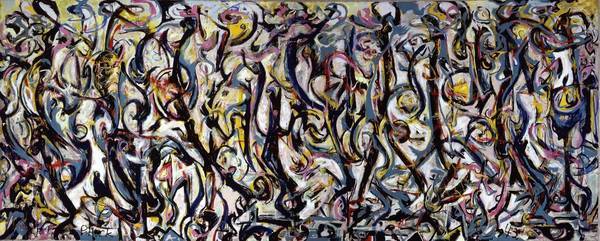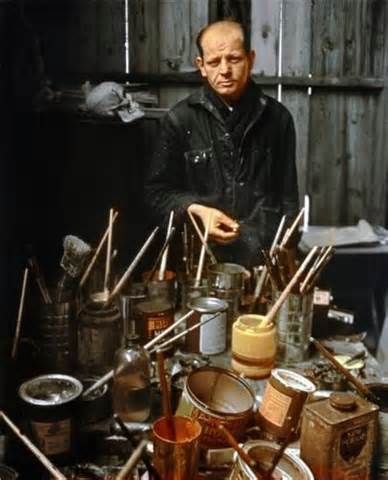Jackson Pollock Masterpiece Painting "Mural" goes on display after Refurbishing:

(If you want to reproduce this painting (Mural) in museum quality standard, please inform us through our Guest Book http://www.oilpaintingcentre.com/form/GuestBook/ or send email to us (romandyart@yahoo.com). We will do with our all-out efforts to provide you our top quality paintings and reach your 100% satisfaction. Thank you.)
Mural, one of the brilliant Jackson Pollock paintings that took 20th century American art in a new direction, has re-emerged from seclusion with a stunning face-lift that’s given it a brighter look and an even more towering presence than it had before.
This oil painting masterpiece that measures more than 8 feet tall and nearly 20 feet long has been under wraps at the J. Paul Getty Museum for more than a year, undergoing an extensive restoration.
Painted in 1943 for wealthy art collector Peggy Guggenheim, Mural represents a key moment in Pollock’s career in which he began to move from creating more symbolic, regional forms to the abstract expressionism of his “drip” paintings that would both distinguish his career and transform the art world.
“Mural made a cultural shift in a modern artist who redefined art in the 20th century,” Jim Cuno, the J. Paul Getty Trust’s president and CEO, said before museum officials took reporters on a tour of the gallery where the work will hang until June 1.
When visitors to the hilltop museum got their first glimpses of Mural Tuesday, the first thing they might have noticed was a far more colorful work than the one that hung for decades in the University of Iowa Museum of Art, which received it as a gift from Guggenheim in 1951.
Restorers painstakingly removed a varnish put in place during a 1973 restoration. Although that restoration likely saved the painting, the varnish substantially dimmed the intensity of its colors, said Yvonne Szafran, head of paintings conservation for the Getty.
As restorers returned the work to its original luster, they were also able to dispel some of the many myths surrounding it. The key one, perhaps, was that Pollock created the masterpiece in one nonstop burst of energy that began on New Year’s Eve, 1943, and lasted 24 to 36 hours.
Although the artist told his brother he spent the summer of 1943 working on it, the marathon myth was spread by Guggenheim and Pollock’s wife, and might have been the result of a misunderstanding.
Restorers noticed that Jackson Pollock’s initial paint marks, which cover the whole canvas, were made in four highly diluted colors and they could have been put on in a day, said Tom Learner, head of the Getty Conservation Institute. The other more substantial additions would have taken much longer to dry.
A detail of Jackson Pollock’s ‘Mural,’ which is on display at the J. Paul Getty Museum in Los Angeles. A detail of Jackson Pollock’s ‘Mural,’ which is on display at the J. Paul Getty Museum in Los Angeles.
Jackson Pollock was only 31, and a relative unknown, when he completed the work. In the years that followed he would shake up the art world with his “drip paintings” that used house paints that he would pour directly onto canvases placed on the floor.
Although there’s no evidence he placed Mural on the floor, and its many brush strokes are obvious, restorers did discover the use of house paint on parts of the canvas. The rest was created with high-quality artists’ oils.
The painting, filled with colorful, twisting animal-like forms, was described by the artist himself as representing a stampede of animals from the American West.
“We can’t say with certainty that it’s the first known use of house paints by Pollock,” Learner said as he pointed out areas where it was used. “But it’s the earliest known analyzed use.”
When Pollock finished the painting it wouldn’t quite fit into the entryway to Guggenheim’s New York City apartment, so the ends were folded slightly. That prompted rumors it had been cut.
“It definitely wasn’t cut,” Learner said, noting the ends have been restored to view.
After the painting leaves the Getty in June it will go to Iowa’s Sioux City Art Center, where it will be displayed for several months. There are tentative plans to take it on a world tour after that before returning it to Iowa, where a new museum is being built.
To allow people to view a painting of such significance is key to the University of Iowa Museum of Art’s educational mission, said Sean O’Harrow, the Iowa museum’s director.
“This is a generation that believes the world is on an iPhone and as long as you see a picture of it, you have experienced the work,” he said Monday. “Well, obviously that’s not the case.” (From The Blade News)
Biography of Jackson Pollock:
Paul Jackson Pollock (Jan.28, 1912 – Aug.11, 1956), known as Jackson Pollock, was an influential American painter and a major figure in the abstract expressionist movement. He was well known for his unique style of drip painting.
During his lifetime, Jackson Pollock enjoyed considerable fame and notoriety, a major artist of his generation. Regarded as reclusive, he had a volatile personality, and struggled with alcoholism for most of his life. In 1945, he married the artist Lee Krasner, who became an important influence on his career and on his legacy.
Jackson Pollock died at the age of 44 in an alcohol-related, single-car accident; he was driving. In December 1956, several months after his death, Pollock was given a memorial retrospective exhibition at the Museum of Modern Art in New York City. A larger, more comprehensive exhibition of his work was held there in 1967. In 1998 and 1999, his work was honored with large-scale retrospective exhibitions at MoMA and at The Tate in London.
In 2000, Jackson Pollock was the subject of an Academy Award-winning film Pollock directed by and starring Ed Harris.
Edited by Kevin from Xiamen Romandy Art Limited.
Founded in 2001, Xiamen Romandy Art Co., Ltd. is one of the leading oil painting suppliers engaged in the production of handmade oil paintings in China. Our high quality products and excellence in service have helped us to enjoy a high reputation among our clients. Our overall goal is to continue to improve the quality of our products and service in the future.
Tags: Jackson Pollock Masterpiece Painting "Mural" goes on display after Refurbishing.
|